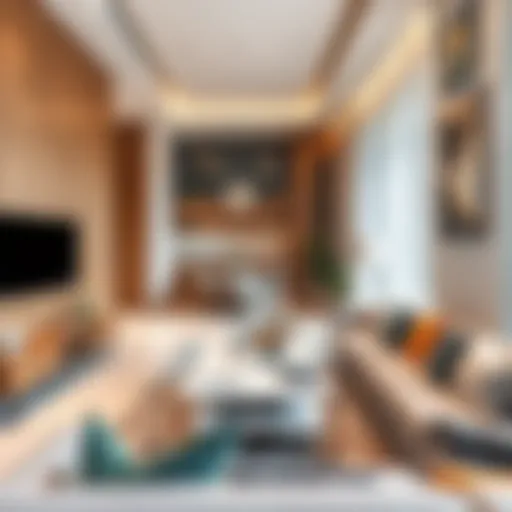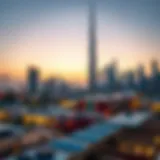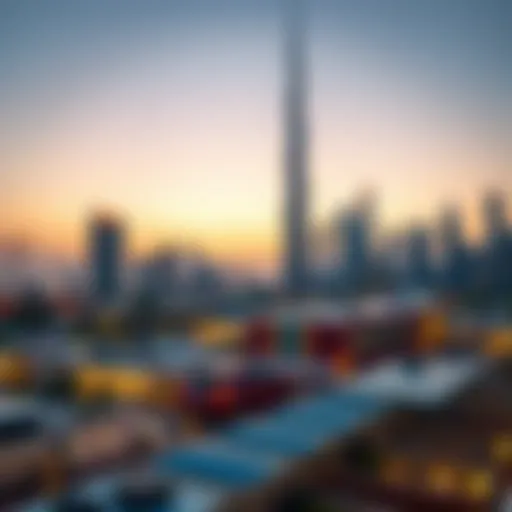Exploring Skyline Properties in Dubai's Real Estate
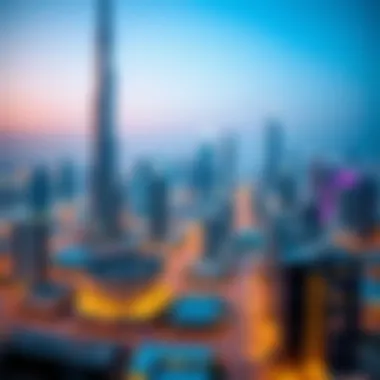
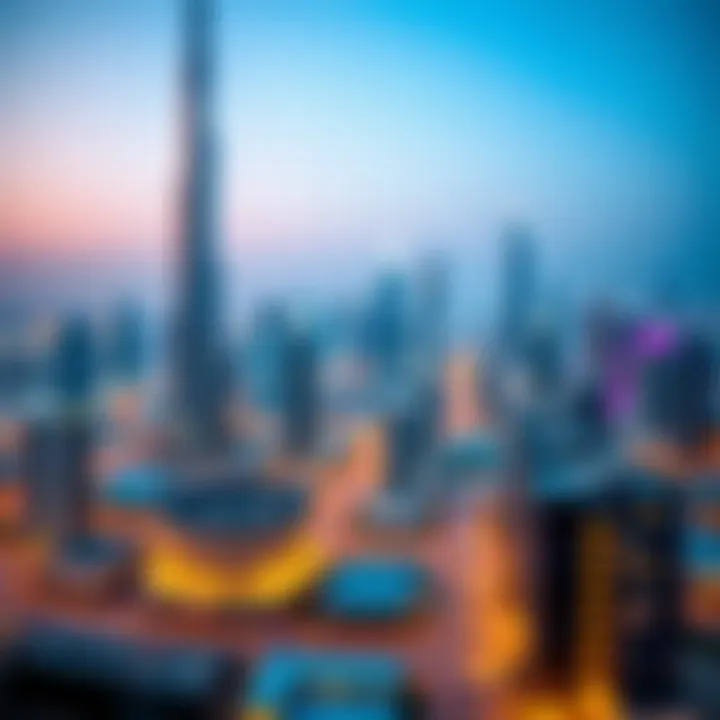
Intro
Dubai's skyline is nothing short of iconic, with towering structures that pierce the clouds and define the city’s identity. As urban areas grow, the demand for high-rise properties becomes more pronounced. The blend of architectural brilliance, luxurious amenities, and visionary designs makes Dubai a hotbed for skyline properties. Investors, agents, and lifestyle seekers alike find themselves drawn to these high-rise marvels, seeing not just buildings but also the potential for lucrative investment and enhanced living experiences.
This article delves into the intricacies of skyline properties within Dubai's bustling real estate sector. It takes a close look at how these towering structures influence the market trend dynamics, the factors that contribute to their appeal, and what this all means for those looking to navigate the urban real estate landscape. The exploration includes essential insights for making informed decisions in a market that can often feel overwhelming.
From understanding the architectural significance of these iconic properties to dissecting the investment aspects, we aim to furnish an informative guide that serves the needs of a diverse audience. Whether you're an investor keen on exploring opportunities, a real estate agent seeking to enhance your market knowledge, or a homeowner dreaming of the luxury lifestyle, this article offers a roadmap through the world of skyline properties in Dubai.
Prelude to Skyline Properties
In the bustling heart of Dubai, skyline properties play a pivotal role in shaping not just the landscape but also the economic fabric of the city. As urban centers evolve, these towering structures have become synonymous with luxury living, progressive architecture, and real estate investment opportunities. This section provides a foundation for understanding why skyline properties are more than mere buildings; they embody the spirit of growth, ambition, and cultural significance in Dubai.
High-rise buildings, often adorned with state-of-the-art designs and cutting-edge materials, are key to Dubai's identity. The stunning visual appeal draws attention and evokes pride among residents and visitors alike. Recognizing this, investors are increasingly focusing on skyline properties not only for their potential returns but also for their cultural and aesthetic value. However, it’s important to note that investing in these properties comes with its set of challenges, including market fluctuations and regulatory requirements, which warrant careful consideration.
By delving into the architectural wonders and investment prospects of skyline properties, readers can appreciate how these structures enhance urban living while also presenting a wealth of opportunities. The intricate dance between architecture and investment dynamics requires a comprehensive approach, ensuring that every stakeholder—be it investors, homeowners, or real estate agents—understands this market thoroughly.
Defining Skyline Properties
When we use the term skyline properties, we refer to structures that define a city's skyline through their height, design, and cultural resonance. In Dubai, this definition encompasses a wide array of buildings, from residential towers to commercial complexes, that punctuate the city’s skyline with grandeur and flair. These properties are not only about size; they represent the pinnacle of architectural innovation, often blending traditional elements with modern designs.
Skyline properties in Dubai have become landmarks that resonate with both residents and tourists. Each structure tells a story, reflecting the aspirations and dreams of both their creators and the people who inhabit them. The Burj Khalifa, for example, isn’t merely a tall building; it is a symbol of human achievement and a testament to the innovative spirit of Dubai itself.
The Architectural Appeal
The architectural aesthetics of skyline properties add immense value to the Dubai real estate market. The design elements often reflect a fusion of luxury and functionality, catering to the tastes of a diverse clientele. High-rise buildings like the iconic Burj Al Arab and the elegant Marina 101 stand as tributes to modern architecture, integrating cutting-edge technology and sustainable practices.
Properties adorned with unique features such as panoramic views, green spaces, and innovative living solutions are particularly appealing. Residents find value not just in a place to live, but in a lifestyle enriched by the proximity to amenities, entertainment, and community life.
"Architectural innovation is not just about building upwards; it’s about crafting a vertical canvas that represents the city’s soul."
The architectural appeal extends beyond beauty; it’s intrinsically tied to the promise of an elevated lifestyle. These properties often attract a clientele that values exclusivity and luxury, which further drives demand. As skyscrapers continue to rise, they invite both domestic and international investors to partake in a market that has no signs of slowing down. By understanding skyline properties, one gains insight into the very heartbeat of urban living in Dubai.
The Dubai Skyline: A Unique Perspective
The Dubai skyline is not just an array of buildings; it represents the pinnacle of architectural innovation and urban planning in the heart of the Middle East. The significance of this unique skyline lies in its ability to capture the essence of what modern living can embody—luxury, convenience, and a blend of cultures all beautifully harmonized into one space. For investors, agents, expatriates, and homeowners, understanding the dynamics of Dubai’s skyline is crucial as it influences economic trends and lifestyle choices in profound ways.
Iconic Developments Shaping the Skyline
When discussing the skyline of Dubai, several iconic landmarks immediately come to mind. The Burj Khalifa, towering at 828 meters, is a beacon of modern engineering. It’s not just the tallest building in the world; it’s a symbol of ambition and perseverance. Constructed with affordability in mind, it draws both local inhabitants and international travelers alike, fostering a spirit of adventure and ambition. Properties in proximity to such landmarks see a marked increase in demand, offering a tantalizing opportunity for savvy investors.
Additionally, developments like the Burj Al Arab and Dubai Marina showcase cutting-edge architectural styles that set a profound standard for future projects. Each of these developments has, in its own right, revolutionized what it means to live in a skyscraper. As demand for luxury accommodations rises, especially among expatriates seeking a taste of opulence, these iconic structures continuously impact not only property values but also the lifestyle for those living in their shadows.
Technological Advancements in Construction
The technology behind modern construction has evolved dramatically, particularly in a bustling city like Dubai. Innovative materials and advanced engineering techniques have allowed developers to push the boundaries of what is possible. For instance, the use of reinforced concrete has enabled buildings to reach new heights, both literally and figuratively.
Notably, the implementation of green building technologies is becoming increasingly prevalent. Developers are investing in energy-efficient systems and sustainable practices, such as solar panels and green roofs. These advancements ensure that properties are not only visually stunning but also environmentally responsible—an essential consideration as climate concerns escalate globally.
Furthermore, smart technology has embedded itself into the architectural fabric of Dubai. Many high-rise developments now offer automation systems that allow residents to control everything from temperature to lighting via smartphone applications. This level of convenience and efficiency attracts tech-savvy investors and expatriates, who are drawn to the prospect of high-tech living spaces.
In summary, the unique perspective of the Dubai skyline is shaped by its iconic developments and the technological advancements that define modern urban living. It offers a kaleidoscope of investment opportunities while presenting a lifestyle that merges luxury with practicality. As the city continues to grow, so too will the narrative surrounding its skyline, making it a critical area for exploration for anyone involved in the Dubai real estate market.
Investment Opportunities in Skyline Properties
Investing in skyline properties in Dubai offers a unique blend of architectural wonder and financial potential. A skyline isn't just a collection of tall buildings; it's a vibrant testament to urban growth, modernity, and lifestyle ambitions. For investors, agents, and expatriates, understanding this segment opens doors to lucrative opportunities. With Dubai's continuous evolution and appeal to tourists and expatriates, the demand for high-rise living is rising. This demand generates a wealth of investment prospects that can lead to substantial financial returns.
Market Trends and Analysis
The real estate market in Dubai has exhibited remarkable resilience and dynamism, especially in the skyline segment. Recent trends reveal that premium properties in high-rise developments are not only in demand but also witnessing significant price appreciation. Many investors have shifted their focus toward luxury apartments overlooking stunning views of landmarks like the Burj Khalifa and the Dubai Marina. Both local and international buyers are showing increased interest, a trend fueled by a recovering economy post-pandemic and growing expatriate populations.
In 2023, residential units in skyline properties reported over a 20% increase in sales year-over-year, according to the Dubai Land Department. It’s essential for investors to monitor fluctuations in the market carefully, focusing on neighborhoods with upcoming developments, as these areas often promise higher returns on investment.
Furthermore, the implementation of ambitious government initiatives, such as the Dubai Vision 2040, aims to promote sustainable urban living. This focus on sustainability augurs well for skyline properties, making them attractive options for long-term investment.
Assessing ROI and Value Appreciation
When evaluating the return on investment (ROI) for skyline properties, several factors come into play. These include location, amenities, and the overall market condition at the time of purchase. Properties situated in prime locations usually see faster appreciation rates. Notably, the proximity to public transportation and major attractions can significantly enhance a property’s allure and value over time.
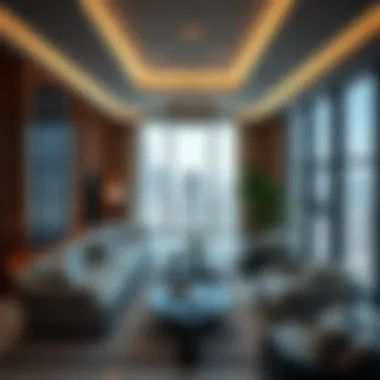
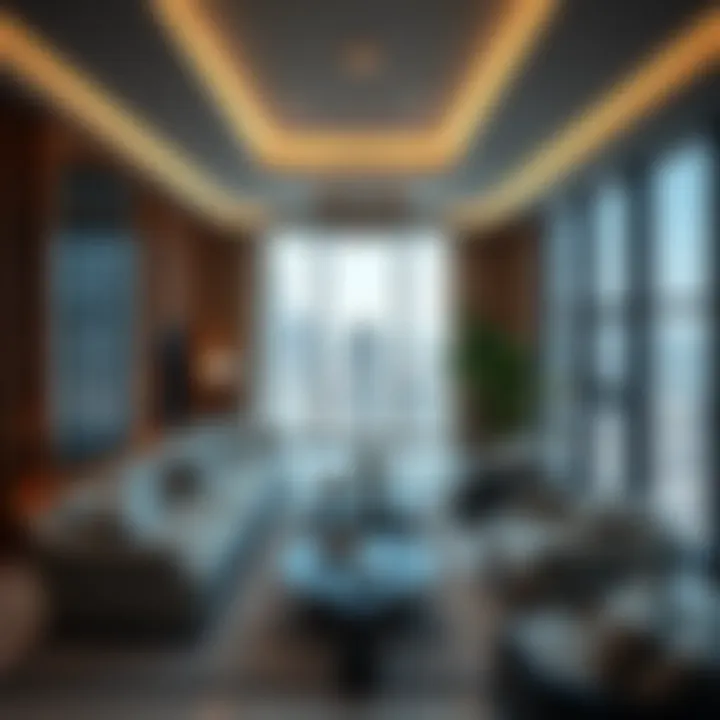
For instance, properties within The Marina District offer not just luxury living but also access to vibrant nightlife, dining, and cultural experiences. This makes them hot commodities among both renters and buyers alike. Investors typically look for a minimum ROI of 8% to 10% on properties in these coveted areas, given the high demand and bustling lifestyle they provide.
In terms of value appreciation, historical data indicates that property values in Dubai’s skyline areas have shown a consistent upward trend over the years. In a 10-year projection, many properties have been known to double in value, particularly when substantial infrastructure projects are introduced nearby.
"Investors should prioritize properties that offer not just aesthetic value, but also practical benefits such as good governance and a stable community."
Lifestyle Benefits of High-Rise Living
High-rise living has become synonymous with luxury and modernity, particularly in urban environments like Dubai. The soaring towers that punctuate the skyline offer not just a place to reside but also a unique lifestyle molded by convenience, connectivity, and the vibrant energy of the city below. Understanding these benefits can guide potential investors and residents alike towards making informed choices.
Amenities and Services
When you opt for high-rise living, you step into a realm of availability that can often feel like a mini-city within a building. Many of these skyscrapers come laden with a plethora of amenities designed to cater to every desire and need of their residents.
Common amenities include:
- Swimming Pools: Roof-top pools offer breathtaking views of the city, making your swimming experience much more than just an errand.
- Fitness Centers: Many towers house state-of-the-art gyms that invite residents to stay fit without needing to step outside.
- Concierge Services: Imagine having someone at your beck and call to manage reservations or schedule services, adding a layer of convenience to your busy life.
- Retail Outlets: From grocery stores to boutique shops, many high-rises integrate commercial spaces, reducing the need to travel far for daily essentials.
Services do not stop at physical amenities. Here, you might also find technology that enhances your living experience. Smart home systems allow for automation and control over lighting, temperature, and security right at your fingertips. The blend of tangible amenities and technological advancements is alluring for homeowners; it elevates everyday living to a more enjoyable and convenient existence.
Community and Social Dynamics
Living in a high-rise can sometimes feel like living in a fish bowl; everyone is close, yet you all have your individual lives. This unique setup creates distinct social dynamics that can significantly enhance one’s lifestyle in urban settings.
- Diverse Neighborhood: High-rises often bring together residents from various backgrounds, cultures, and professions, fostering a rich shared experience. This diversity can lead to fascinating interactions and friendships, unlike those found in more traditional or suburban neighborhoods.
- Community Activities: Many high-rise buildings host events, from seasonal parties to fitness classes, building a sense of belonging among residents. It’s one thing to share an address; it’s another to share experiences.
- Shared Spaces: Amenities such as lounges, rooftop gardens, or communal terraces encourage residents to mingle. These gathering spots can turn strangers into friends and can inspire a sense of community that thrives, even in vertical living.
The communal aspect of high-rise living establishes connections that could be hard to find elsewhere. Residents become part of something larger than themselves, creating bonds that elevate the living experience.
In essence, high-rise living in Dubai is not just about lofty views. It’s about embracing a lifestyle that combines modern amenities with vibrant community engagement, enriching the lives of those who call these towers home. From the broad array of services to the active social landscape, the benefits are noteworthy and compelling for anyone considering this unique living situation.
Regulatory Landscape for Skyline Properties
Understanding the regulatory landscape for skyline properties is a cornerstone of any serious discourse on real estate in Dubai. Given the rapid pace at which urban development evolves, the laws governing these high-rise structures play a pivotal role. They not only affect the investment environment but also dictate the sustainability and livability of these colossal edifices.
Local Real Estate Laws
Local real estate laws in Dubai are akin to the blueprint that guides property development. These laws encompass various aspects such as ownership rights, investment structures, and lease terms. One important feature is the concept of freehold vs leasehold properties:
- Freehold properties offer complete ownership, allowing investors to own land and buildings indefinitely.
- Leasehold properties provide rights for a fixed term, typically up to 99 years.
These distinctions can have profound implications on investment strategies. In addition, it's essential to be aware of the rules set by authorities like the Dubai Land Department, as they dictate how transactions are conducted, ensuring transparency and security for buyers and sellers alike. This is where understanding the legal jargon can indeed save you money, or, even better, help to avoid nasty surprises. The laws not only protect investors but also uphold consumer rights, ensuring that any issues concerning property disputes or fraud can be legally addressed.
Zoning and Building Regulations
Zoning and building regulations in Dubai are crafted to manage the explosive growth of skyscrapers and ensure that urban development is sustainable. These regulations guide the function and design of buildings, determining:
- Building heights: Certain areas, like the Dubai Marina, are designed for high-rises, while others may have restrictions.
- Setback requirements: These ensure buildings are positioned away from the street to promote better urban design and facilitate movement.
- Environmental standards: Adhering to sustainable practices is increasingly becoming non-negotiable, impacting how buildings are constructed and maintained.
A hefty part of the regulatory framework also revolves around encouraging developers to adopt innovative construction techniques and materials. This becomes glaringly apparent when you consider recent movements towards eco-friendly designs. It is important to mention that failing to comply with these regulations can lead to steep fines or even the halting of construction.
The zoning laws, therefore, are not just bureaucratic red tape but serve to protect the interests of the inhabitants and the investment community, ensuring that the city remains well-organized and attractive to expatriates and tourists alike.
Understanding the regulatory landscape helps investors navigate the complexities of high-rise investments, ensuring that opportunities align with laws governing the Dubai skyline.
The Role of Skyline Properties in Urban Development
The landscape of urbanization in a city like Dubai has been significantly shaped by its skyline properties. These towering buildings do not merely scrape the sky; they symbolize the ambition, vision, and progress of a nation that aims to be a major player on the global stage. The role of skyline properties transcends mere aesthetics; they are pivotal in improving urban infrastructure, enhancing economic dynamics, and providing a vibrant lifestyle for their inhabitants.
Impact on Urban Infrastructure
High-rise buildings are often complex structures that necessitate intricate planning and robust infrastructure. As Dubai continues to grow, skyline properties contribute to essential infrastructure improvements, including road networks, public transport systems, and utilities that ensure a modern urban experience. Here are several significant aspects to consider:
- Transportation Hubs: Developments such as the Burj Khalifa have catalyzed improvements in nearby transportation facilities. The presence of these iconic structures often leads to investments in metro stations, bus services, and taxi availability. Access becomes imperative, making once-isolated areas vibrant social hubs.
- Utilities and Support Services: The construction of high-rises typically requires a reevaluation of water supply, electricity distribution, and waste management systems. Providers often upgrade existing infrastructure or create new systems to meet the demands of both residents and commercial enterprises.
- Public Amenities: Skyline properties frequently come equipped with community-focused amenities: parks, gyms, swimming pools, and retail spaces that provide a rich tapestry of urban living. These features enhance livability and attract a diverse population seeking a blend of comfort and convenience.
These buildings do not just occupy physical space; they effectively reimagine urban life by transforming underused areas into bustling communities.
Environmental Considerations


While the economic and infrastructural contributions of skyline properties are invaluable, their impact on the environment must not be overlooked. Urban development, particularly high-rise construction, carries with it a set of challenges that need careful navigation to foster a sustainable future:
- Energy Consumption: High-rise buildings often require vast amounts of energy for heating, cooling, and services. Integrating sustainable technologies—such as solar panels or energy-efficient systems—can mitigate their carbon footprint and optimize energy usage.
- Water Management: The relationship between high-density living and water conservation is complex. Urban developments like Dubai must implement effective strategies for rainwater collection and waste recycling to address water scarcity in desert climates.
- Green Spaces: Balancing concrete with greenery is vital. The incorporation of rooftop gardens, vertical parks, and open communal areas can significantly enhance the surrounding environment, improving air quality while providing residents with a patch of nature amidst the urban sprawl.
The approach to exploration around skyline properties must be multifaceted, addressing both the human experience and environmental integrity.
"Urban development is not just about building; it’s about crafting communities that can thrive sustainably."
For more information about urban dynamics and planning, you can explore Wikipedia on Urban Planning and Britannica on City Planning.
Additionally, community discussions surrounding skyline developments can be found on platforms like Reddit.
These insights are vital for anyone looking to engage with Dubai's vibrant landscape, whether as an investor, resident, or simply an interested spectator.
Case Studies: Successful Skyline Projects
The exploration of successful skyline projects offers invaluable insights into their architectural brilliance and investment viability. In the fast-paced world of urban real estate, these case studies illustrate how ambitious projects can redefine city landscapes while providing a blueprint for future developments. For investors and real estate enthusiasts, understanding these exemplary cases highlights the tangible benefits and potential pitfalls associated with high-rise living in Dubai.
Examining Burj Khalifa
The Burj Khalifa stands as the crown jewel of Dubai's skyline, not merely because of its towering height but also due to its intricate design and commercial success. With a height of 828 meters, it holds the title of the tallest building in the world, a feat that reflects both engineering prowess and the ambition of Dubai. This iconic structure is not just about aesthetics; it embodies the entrepreneurial spirit of the city and serves as a hub for luxury business and tourism.
Among the noteworthy features that attract attention is the building's mixed-use functionality. It houses corporate offices, a hotel, apartments, and observation decks which draw millions of visitors each year. The Burj Khalifa has also catalyzed surrounding developments, effectively creating a microclimate of urban activity.
Key Benefits:
- Tourism Magnet: Drawing millions, boosting local economy.
- High-Value Rentals: Premium prices for luxurious apartments, ensuring a consistently high ROI.
The appeal of the Burj Khalifa transcends its physical structure; it's a status symbol for luxury living in Dubai, making it an appealing investment for both local and international buyers.
The Marina District’s High-Rise Developments
The Marina District is another critical area of focus when discussing skyline properties in Dubai. This bustling waterfront development features an array of skyscrapers that not only deliver exceptional views but also contribute to a vibrant lifestyle. The neighborhood is characterized by a lively atmosphere enhanced by restaurants, cafes, and retail outlets lining the marina—all contributing to a cosmopolitan vibe.
Among the most notable developments within the district is the Dubai Marina Mall, which caters to both residents and tourists. The diverse collection of high-rises in the Marina offers a blend of residential and commercial space, catering to a mix of affluent buyers and tenants. The balancing act of living and leisure enhances the allure of urban life, drawing in both expatriates and families.
Considerations to Note:
- Community Amenities: Proximity to leisure and recreational options enhances lifestyle appeal.
- Investment Potential: A balanced mix of residential and commercial properties creates diverse avenues for income generation.
As the Marina District continues to evolve, it shines a spotlight on the growing trend of integrated urban living, marrying convenience with luxury.
“The Marina exemplifies how smart planning can foster community while enhancing property values.”
Challenges in Skyline Property Investments
Investing in skyline properties in Dubai presents its fair share of hurdles. The rapid growth and development in the city, while enticing, come with complexities that investors must navigate skillfully. Understanding these challenges is crucial for anyone looking to enter the bustling market, as it affects both potential returns and the overall investment strategy.
Market Volatility and Economic Factors
Market volatility is a significant concern for investors in skyline properties. The real estate sector often mirrors economic conditions. When the economy is doing well, demand for high-rise living tends to rise, attracting both expatriates and local residents. However, during economic downturns, such as fluctuations in oil prices or global financial crises, the market can shift dramatically. Investors must stay informed about local and global economic indicators, as they impact the accessibility and desirability of urban properties.
Another factor is the competition among investors. As more people flock to Dubai for its luxurious lifestyle and business opportunities, the competition in the real estate sector increases. This fierce competition can lead to inflated property prices, squeezing profit margins for new investors.
There’s also the issue of regulatory changes. The government of Dubai occasionally updates policies or introduces new fees, which can catch unwary investors off guard. Keeping abreast of such changes is vital to adapting strategies effectively. Understanding these economic nuances can help investors anticipate shifts, allowing for a more strategic approach.
Demand Fluctuations and Their Causes
Demand for skyline properties does not remain constant. Several factors contribute to fluctuations in demand, each intertwined with various socio-economic conditions. First, population growth in Dubai, driven in large part by immigration, plays a crucial role. As the city attracts talent across different sectors, the need for housing rises, and thus the demand for high-rise living increases.
However, it’s not all smooth sailing. Shifts in lifestyle preferences also dictate demand. Some individuals may seek out larger homes, especially post-pandemic, favoring lower-density areas rather than life in high-rises. This transition can contribute to dips in demand for skyline properties.
In addition, macroeconomic factors—like changes in interest rates, inflation, and currency stability—can all influence the purchasing power of potential buyers. A strong dirham may attract expatriates, while a weaker one could deter investments. Understanding these cultural and economic influences on demand is essential for making informed investment decisions.
"Navigating the complexities of skyline property investments requires a keen awareness of both external market conditions and internal demand dynamics."
By paying close attention to these fluctuations and their causes, investors can position themselves better to capitalize on opportunities while mitigating risks. Building a comprehensive understanding of both local and international trends can provide a clearer roadmap to successful investments in Dubai's skyline real estate.
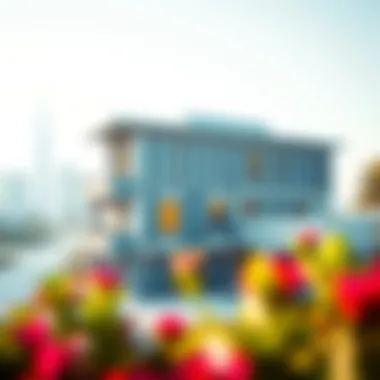

Comparative Analysis: Skyline Properties Globally
The importance of this comparative analysis lies in realizing how Dubai's skyline properties hold up against those in other global cities. On one hand, Dubai's skyline is an impressive feat of modern engineering and design, showcasing a blend of cultural influences and innovative architecture. On the other, the dynamics of urban real estate market worldwide can provide essential insights that help investors, agents, expatriates, and homeowners alike to understand potential opportunities and threats in their investment strategies.
Through comparative analysis, one could observe key differences in investment patterns, design philosophies, and high-rise living trends. Recognizing these factors becomes paramount when navigating the complexities of Dubai's real estate sector, ensuring that stakeholders make informed decisions.
Comparing with Major Global Cities
When you think about high-rise properties, some cities come to mind immediately, like New York, Shanghai, and London. Each city has built its brand on distinct architectural styles and market strategies that shape its skyline. For instance, New York showcases historic yet modern structures, like the Empire State Building and the One World Trade Center. Conversely, cities like Shanghai flaunt futuristic designs with buildings like the Shanghai Tower. These architectural differences not only highlight cultural diversity, but also point to varying investment trends.
In Dubai, skyscrapers like Burj Khalifa and The Address Downtown invoke a sort of boldness and ambition. Here, towers aren't merely produced for functionality; they embody a lifestyle statement. Investors can compare occupancy rates, rent values, and market growth in these cities to sharpen their senses toward what is viable.
- High-Rise Living: New York often emphasizes luxury in limited space while Dubai focuses on vertical expansion with sprawling amenities.
- Market Trends: While Western cities sometimes see slower growth due to regulatory frameworks, markets in Dubai can experience rapid price fluctuations driven by supply and demand.
- Cultural Significance: In places like Paris, for instance, traditional values maintain a significant stronghold. Yet in Dubai, built environments obscure fierce competition between brands.
These factors come together to paint a bigger picture regarding investment opportunities, allowing homeowners and agents to venture into decisions with a calculator rather than just a dream.
Lessons Learned from International Markets
Examining skyline developments from a global lens can yield valuable lessons for investors in Dubai. One critical takeaway is understanding how regulatory environments can drastically impact property values and investment potential. For example, NYC regular property taxes and zoning restrictions can stifle new constructions and renovations, leading to a limited supply, while Dubai, with its relatively flexible regulations, often enjoys an influx of new projects.
Future of Skyline Properties in Dubai
The landscape of skyline properties in Dubai is at a significant crossroads, with its future promising an intriguing blend of innovation and strategic development. As investors and stakeholders scrutinize the shifting dynamics of the urban real estate market, it becomes crucial to understand the emerging trends and innovations that will shape the city's architectural narrative. The importance of this analysis lies not only in recognizing the potential return on investment but also in comprehending the socio-economic implications of these towering structures.
In this section, we'll explore the specific elements redefining the future of skyline properties, the benefits of these advancements, and critical considerations for those interested in tapping into this vibrant market.
Emerging Trends and Innovations
In Dubai, evolution is the name of the game. The city's skyline is constantly changing, driven by advancements in architecture and construction technologies. One can expect to see the following trends influencing the skyline properties:
- Sustainability Practices: Developers are now prioritizing eco-friendly designs, with a great emphasis on energy efficiency. For instance, projects like the Sustainable City incorporate renewable energy sources, resulting in lower operational costs and reduced environmental impact.
- Smart Buildings: Technology is increasingly integrated into high-rise living. Homes equipped with smart technology for energy management, security systems, and even waste management are becoming more prevalent.
- Mixed-Use Developments: High-rises blending residential and commercial spaces are gaining traction. Properties such as Downtown Dubai’s high-rise mixed-use complexes allow residents to work and leisure without venturing far from home.
Keeping an eye on these trends is vital for investors and future homeowners, as they affect property values and market demand. Properties that adapt to these trends often experience longer-lasting value appreciation.
Predictions for Market Evolution
With the pace of change in mind, making sound predictions about Dubai's skyline properties requires a discerning eye on broader economic and socio-political factors. Here are a few forecasts for the market's trajectory:
- Continued Growth of Luxury High-Rises: As long as Dubai maintains its status as a global tourism hub, the demand for luxury properties is likely to remain robust. Investors can expect a premium on properties located near key attractions like the Burj Khalifa or waterfront views.
- Regulation and Compliance Trends: As concerns grow regarding safety and sustainability, regulators will impose stricter guidelines. Developers who proactively embrace these regulations may find themselves favored in the competitive market.
- Global Economic Influence: The influence of global economic trends on Dubai's property market cannot be underscored. Factors like currency fluctuations, international buyer interest, and geopolitical stability will continue to influence market dynamics.
"The ability to adapt and evolve with changing trends will define the success of skyline properties in Dubai."
In closing, the trajectory of skyline properties in Dubai reflects broader global trends while maintaining a unique flavor derived from its cultural and economic context. Investors looking to enter this domain must keenly observe these shifts. Owning a piece of Dubai's skyline not only symbolizes prestige but also aligns with a forward-thinking lifestyle in a metropolis that never stands still.
The End: The Significance of Skyline Properties
Skyline properties are not just a collection of tall buildings dotting the horizon of Dubai; they represent a nexus of urban development, economic opportunity, and social interaction. Understanding their significance involves not just appreciating their architectural beauty but also recognizing their broader impact on the city’s landscape and community.
These properties serve as a mirror reflecting the aspirations of a modern metropolis, standing tall as testaments to engineering prowess and design aesthetics. They do not merely touch the sky but also redefine the concept of community living. The rising trend of high-rise buildings has transformed not only the skyline but also the demographics and lifestyle of the residents who inhabit them.
A key element to grasp is the dual nature of skyline properties; they are both investments and homes. Investors see potential profits, while residents enjoy the perks of urban conveniences paired with luxurious living. Rationalizing their significance goes beyond numbers or aesthetic appeal. These structures embody a shift toward sustainable living, with many developments incorporating green technologies and community spaces that foster social interaction.
High-rise properties in Dubai host a wealth of amenities—swimming pools, gyms, and rooftop gardens—that enhance quality of life. As urban dwellers increasingly seek a work-life balance, these contributions are not to be understated. Furthermore, the continuous evolution in design and technology in these properties paves the way for future innovations that ensure sustainability, comfort, and community.
"In assessing the significance of skyline properties, one must consider how they influence every facet of urban life, shaping economies and lifestyles alike."
Summary of Key Insights
Summarizing the key insights drawn from this exploration reveals a well-rounded picture of skyline properties in Dubai.
- Urbanization and Growth: The surge in high-rise buildings signifies rapid urbanization and a response to the increasing population density, driving demand for vertical living spaces.
- Investment Potential: High-rise properties continue to entice investors owing to the lucrative returns on investment, supported by thriving tourism and economic stability in Dubai.
- Architectural Marvels: The unique designs of these structures are often considered iconic, drawing attention and elevating Dubai's profile on the global stage.
- Community Living: Many skyline developments foster a sense of community through shared spaces, giving rise to social dynamics that were previously less pronounced in more traditional settlements.
- Sustainability Initiatives: A significant trend is the integration of eco-friendly features, which speaks to the growing awareness around environmental impacts and a shift toward greener living solutions.
In alignment with these insights, it is essential for stakeholders—from investors to residents—to remain cognizant of the changing landscape, equipping themselves with the knowledge to navigate this dynamic sector effectively.
Final Thoughts on Future Prospects
Looking ahead, the prospects for skyline properties in Dubai remain promising, intertwined with both challenges and opportunities. The city's incessant ambition to be at the forefront of innovation influences the type of high-rise developments being constructed.
- As the demand for sustainable living rises, developers are poised to respond by incorporating more eco-friendly technologies and designs into new projects. This will likely attract a demographic that prioritizes sustainability, thereby enhancing the overall appeal of urban living.
- Moreover, with advancements in smart technologies, future skyline properties may integrate systems that enhance living experiences, such as smart home features, advanced security measures, and responsive building technologies that adapt to resident's needs.
- Another emerging trend may revolve around mixed-use developments, enabling residents to live in proximity to workplaces, schools, and leisure activities, which could significantly reshape urban planning in Dubai.
In summary, the significance of skyline properties extends far beyond their physical presence; they represent the dynamic interplay between architectural ambition, economic potential, and community cohesion. As such, they will continue to play a pivotal role in shaping not just the urban landscape of Dubai, but the very way residents experience and engage with their environment.
For further reading and insights into the evolution of urban real estate and the intricate dynamics at play within Dubai, consider visiting Wikipedia, Britannica, and forums on Reddit.



